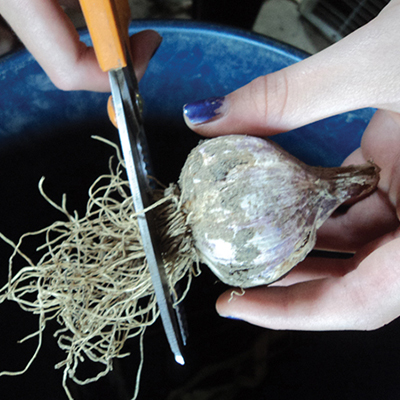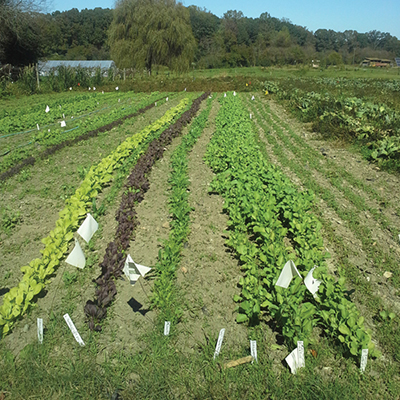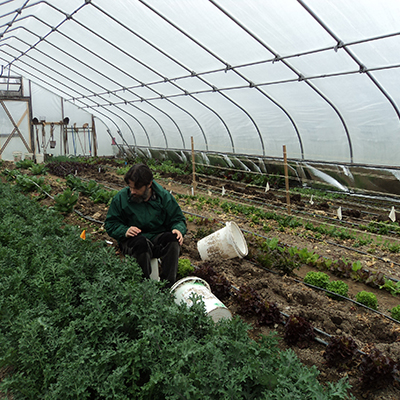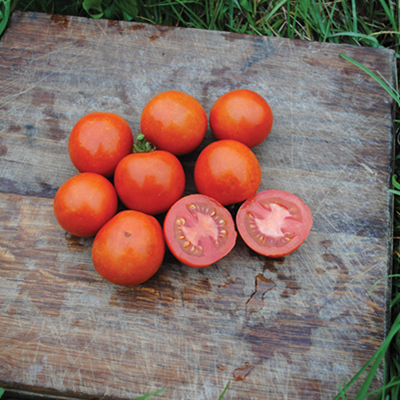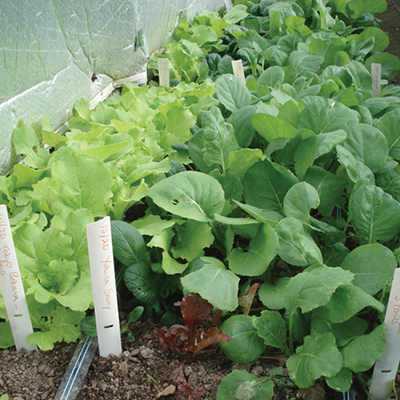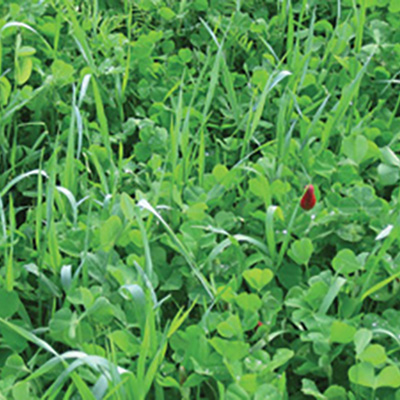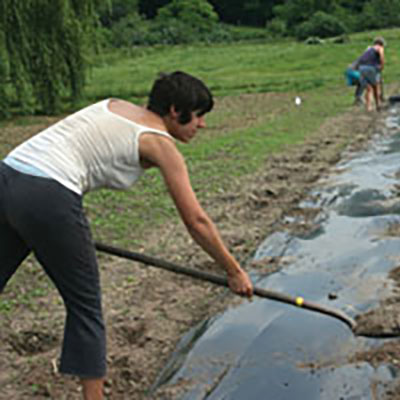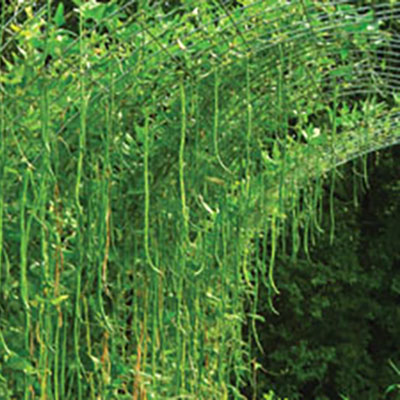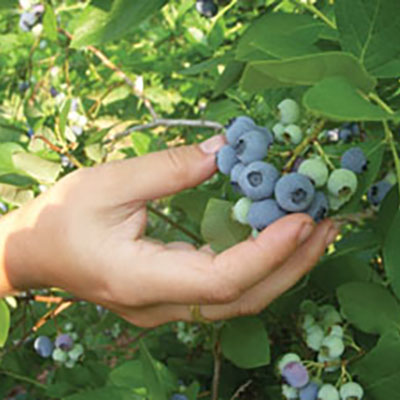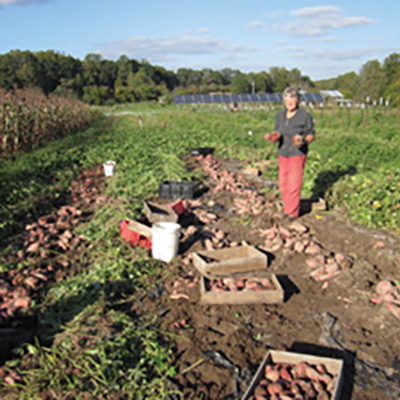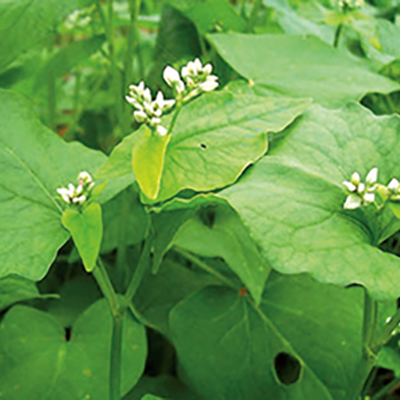We have been growing muskmelons (sometimes called cantaloupes) for many years, and a few years ago added the crisp white-fleshed Asian melons to our repertoire. This year we are also growing Tasty Bites personal-size melons from Johnny’s Seeds. I was going to write an article about personal-size melons (they top out at 3 pounds), but found I hadn’t yet written in Growing for Market about melons at all (other than watermelons). So I’ll leave the individual-size melons for a future article. By then I’ll have more experience with them.
Types of melon
Jeff McCormack of Saving Our Seeds distinguishes eight types of Cucumis melo melon:
Below: One of the author’s favorite muskmelons is ‘Pike’, which is vigorous, high-yielding, and disease-resistant. Fruits can weigh up to 7 pounds. All photos courtesy of Southern Exposure Seed Exchange.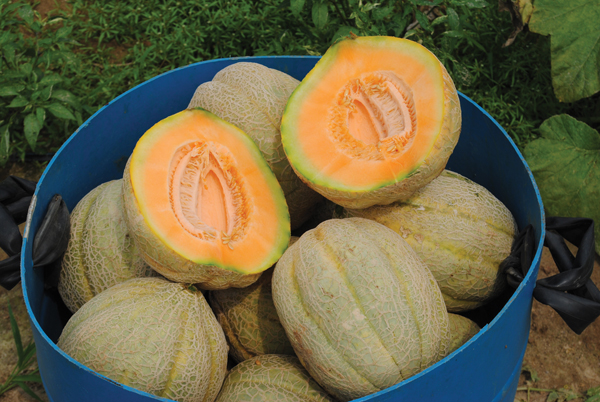 The Cucumis melo reticulatus group includes muskmelons (which we commonly call cantaloupes). They have orange or green flesh and usually have netted skin. They turn beige and slip from the vine when ripe (perhaps with a nudge). They have soft sweet orange flesh.
The Cucumis melo reticulatus group includes muskmelons (which we commonly call cantaloupes). They have orange or green flesh and usually have netted skin. They turn beige and slip from the vine when ripe (perhaps with a nudge). They have soft sweet orange flesh.
True cantaloupes, Cucumis melo cantalupensis, are rarer in the US. They are rough and warty rather than netted. Prescott Fond Blanc and Petit Gris de Rennes are true cantaloupes, as are charentais melons.
Cucumis melo inodorus is the group of winter (‘storage’) melons: casabas, crenshaws, honeydews, and canary melons. They have a smooth rind, no musky odor, and must be cut from the vine - they will not slip.
Cucumis melo dudaim includes Plum Granny and Queen Anne’s Pocket Melon, grown for aroma, not flavor.
The four groups less common in the US are C. m. flexuosus (snake melons, including Armenian cucumbers), C. m. conomon (Asian and Oriental pickling melons), C. m. chito (mango melon and others named after other fruits) and C. m. momordica (snap melons).
In this article I am mostly talking about C. m. reticulatus, and will call them muskmelons.
We used to grow the delicious aromatic netted Ambrosia, before Monsanto bought Seminis Seeds. Now we grow Kansas or Pike from Southern Exposure Seed Exchange. Kansas (90 days) is an heirloom muskmelon with excellent flavor, 4 lbs (1.8 kg), hardy, productive, with good resistance to sap beetles. Pike (85 days) was bred for growing in unirrigated clay soil. It is vigorous, high-yielding, disease-resistant and (depending on irrigation) produces 3–7 lbs (1.5–3 kg) fruits with great flavor. We have also had success with Edisto 47 (88 days, OP), about 6”–7” (15–17 cm) in diameter. With resistance to Alternaria Leaf Spot, Powdery Mildew and Downy Mildew, it exceeds the disease resistance of some hy
brids.
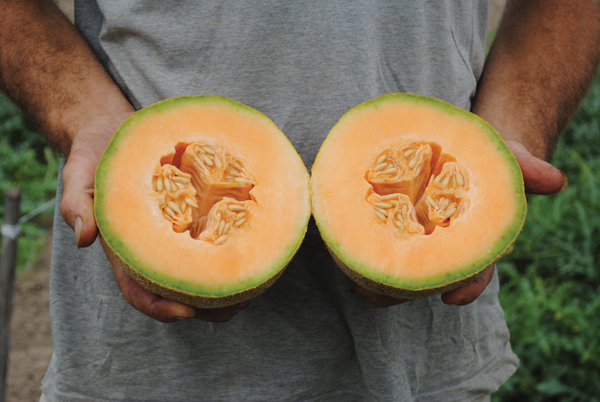 Above: The open-pollinated variety ‘Edisto’ shows more disease resistance than some hybrids. Photo courtesy of Southern Exposure Seed Exchange.
Above: The open-pollinated variety ‘Edisto’ shows more disease resistance than some hybrids. Photo courtesy of Southern Exposure Seed Exchange.
Some “new” personal-size melons are neither new, nor hybrids, but are small heirloom melons with a new marketing twist. We have grown some of these, but they had a green tone to the flesh and skin, and this, combined with the small size, led people to think them not ripe when they were. Green-fleshed and non-slip melons need a well-trained harvesting crew!
Other types of melons such as the fast-maturing crisp-fleshed Asian melons also do well for us. We like Sun Jewel from Johnny’s.
Baker Creek may hold the record for the most OP melon varieties (approximately 100, not including watermelons, bitter melons, wax melons or any of the less common types). Another source for many unusual melons is Seedman.com www.seedman.com.
Crop requirements
Melons require a fertile, well-drained soil with a pH of 6–7 and plenty of sunshine. They have no frost tolerance. Adequate water is especially important in the seedling stage and during fruiting. Vines can sprawl and cover a 4-foot (1.2‑m) bed or fill even a 7-foot (2-m) row when grown on the flat. Relatively close spacings will increase yields and provide a more uniform harvest.
Seed specs: 1,000 seeds/oz, 36 seeds/g. 0.5 oz /100’, 6 oz. /1,000’ at 6 seeds/ft (100 seeds, or 11g/m at 2.5 cm spacing). Melon yields will be affected by irrigation during fruit development, but not by watering levels during vegetative or flowering stages. Before growing melons in a big way, ensure there are adequate pollinators around. It takes 10 to 20 bee visits per flower during the one day the flower is open, for a good-shaped and -sized fruit to grow.
Marketable yields of muskmelons can be 7,000–10,000 fruits per acre (17,000–25,000 per hectare) when grown on plastic mulch, and down to half that on bare ground. Most melon plants will yield three or four good melons.
Growing transplants
For melons, warm temperatures are essential. Sow at 68-90°F (20-32°C), ideally 90°F (32°C). Melons are not very easy to transplant, so choose a method that minimizes root damage, such as soil blocks, or 2” (5-cm) deep plug flats that are easy to eject plants from. Sow 2–3 seeds per cell 0.25-0.5” (0.5-1 cm) deep one month (no sooner!) before transplanting outdoors. “Days to maturity” in catalogs are usually from direct seeding; subtract about ten days to calculate from transplanting to harvest date. (We sow our first melons April 15 to transplant with row cover May 6, a week after our last frost date.)
Grow seedlings at 75°F (24°C). Handle young plants gently and never let the soil dry out. Thin to 1 plant/cell with scissors, and reduce water and temperature for a week to harden seedlings. Temperatures below 45°F (7°C) can stunt growth. Melon seedlings (like all cucurbits) are sometimes damaged by foliar sprays, especially ones including soaps, so avoid killing by mistaken kindness. Bring in ladybugs to eat aphids, if these are a problem.
Transplanting
A light, well-drained soil with a pH of 7.0 and a full-sun southern exposure is ideal. When the weather is frost-free, warm and settled, transplant 2-3’ (60-90 cm) apart in rows 6’ (2 m) apart. Wait till the soil temperature at 2” (5 cm) deep is at least 60°F (16°C). Warm overcast conditions late in the day are best for transplanting, and rowcover (preferably on hoops to reduce abrasion) can be used to provide warmer and less breezy conditions. Melon transplants are often leggy and should be planted so that the entire stem up to the base of the leaves is below soil level; otherwise the fragile stem is liable to get broken.
Direct sowing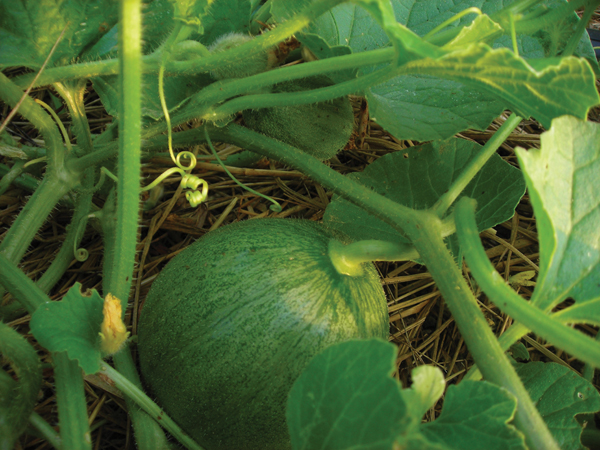 Above: A healthy melon plant at Southern Exposure Seed Exchange.
Above: A healthy melon plant at Southern Exposure Seed Exchange.
For later crops, we direct sow May 25 and June 25, that is, about once a month during the warm-enough season. When direct sowing in open ground we make a furrow 0.5”–0.75” (1.3–1.8cm) deep, water the furrow if the soil is dry, put one seed every 6” (15 cm), pull the soil back over the seeds and tamp down. We use hoops and rowcover until the plants start to flower (about a month) as we have many pests and diseases. When the plants start to flower, we remove the rowcover, hoe and thin to 18”–24” (45–60 cm). Melons can use 7.5–15 ft2 (0.7–1.4 m2) each on plastic mulch, and double that space on bare ground. Melon rows are typically up to 6’–10’ (2–3 m) apart. It is possible to sow through plastic mulch by jabbing holes in the plastic and popping the seeds in. This leads to earlier harvests, as the mulch warms the soil, and there will be no weeds.
Caring for the crop
Melons won’t taste sweet if the weather is indifferent in temperature, very cloudy or the plants are diseased (without good leaves, photosynthesis is restricted, meaning a shortage of sugars). Good soil moisture is important in the early stages of growth and during pollination when fruits are setting. After this point do not water unless the soil is very dry and leaves begin to show signs of wilting in midday. In bare soil, hoe and thin the plants if you sowed thickly.
Drip irrigation and plastic mulch (biodegradable or other) can do a lot to improve the quality, yield and earliness of melons. Plastic mulches can also reduce cucumber beetle numbers, as they deter egg laying and larval migration. Reflective mulches especially reduce beetle populations.
Avoid working the crop (including harvesting) when the foliage is wet, as fungal diseases spread this way. In warm weather, when rowcover is not needed for extra warmth, ProtekNet is useful for keeping bugs off young plants. It’s a small mesh synthetic fabric that keeps bugs off, while letting sunlight, air and water through. www.duboisag.com/en/proteknet-insect-netting.html
Rotations
Because of the many cucurbit pests and diseases, good crop rotation is important. Cucumber beetles are quite mobile, so rotation to a field next to last year’s crop will not reduce their numbers. To minimize their chances, always till in cucurbit crops residues at the first opportunity.
Succession planting
As a rule of thumb, in spring, make another sowing when the first true leaf appears in the previous sowing. In summer, make the next sowing when you have 80 percent emergence of the previous planting. We sometimes sow three plantings of muskmelons, 4/15, 5/25 and 6/25. The recommended last date for sowing melons is 100 days before the average first frost date (July 6 for us).
Season extension
Early crops can be grown in a hoophouse, using transplants, with rowcover added on cold nights. Research at Virginia Tech has shown success with Asian melons such as Jade Star, Sun Jewel and Emerald Sweet transplanted into hoophouses at the end of March at their Petersburg, Virginia location. The Missouri Extension publication High Tunnel Melon and Watermelon Production by Lewis Jett http://extension.missouri.edu/p/M173 includes a valuable section on the botany of melons and watermelons. Although this publication isn’t solely on organic production, it includes high-quality information on producing transplants and setting them out in a high tunnel (hoophouse). Trellising enables the plants to be grown at twice the outdoor planting density.
Insect pests
As always, encouraging beneficial insects and predators will reduce pest numbers.
Soldier beetles (Pennsylvania leatherwings) and wolf spiders are good predators. Heterohabditis nematodes, available commercially, can control cucumber beetles, and may carry over into the next year. Spotted and striped cucumber beetles cause feeding damage and transmit bacterial wilt and squash mosaic virus. Rowcover will keep beetles from vines, but will need to be removed when the female flowers open.
Some people report good control using the yellow plastic sticky traps along with the cucumber beetle lure sachets sold by Johnny’s Seeds. These can last a whole season and be moved from one crop to the next, suspended on wire hoops. To make your own sticky traps, use yellow plastic cups stapled to sticks so the cups are just above foliage height. Coat the cups with one part petroleum jelly to one part household detergent (if you are not prevented by USDA certification) or the insect glues available commercially. Cucumber beetles are attracted by clove and cinnamon oils, which can be used to lure them. Use one trap per 1,000 ft2 (92 m2). Another approach is to grow a trap crop of a variety particularly attractive to the beetles, such as Cocozelle summer squash, Seneca or Dark Green zucchini, along the edge of the field. The trap crop is then flamed or tilled in when pest numbers build up. If all else fails, and action is imperative, Spinosad will kill them. Neem doesn’t kill them, but does deter them.
The brown marmorated stink bug (BMSB) can be a very serious problem. It has more than 300 host species, feeding on almost any fruit or podded crop, causing tremendous damage and, so far, it has no reliable methods of control, organic or otherwise. It has several generations per year in the South. Low-cost tactics to try include growing in caterpillar tunnels or hoophouses with insect mesh and enclosed bee colonies. A succession of trap crops including buckwheat, triticale, sunflower, millet, field pea and sorghum and others such as pumpkins, cowpeas and other small grains (which are most attractive in the milk or soft dough stage) could help. Flaming the trap crops works well.
Predatory stink bugs, assassin bugs, spined soldier bugs and two native egg parasitoids reduce the BMSB numbers, but do not give adequate control. Several egg parasitoids from China may be released from quarantine in the U.S. in future.
Diseases
To minimize diseases choose disease-resistant varieties, provide favorable growing conditions, plow in or remove and compost plant refuse, and control insect pests. Diseased foliage reduces the ability of the fruit to develop sugars: melons from plants with powdery mildew will never taste good.
Angular leaf spot (bacterial) occurs during cool, wet weather. Symptoms include interveinal browning of the leaf and small round spots on the fruit. The leaf damage is tan, rather than dark.
Anthracnose, a fungus disease, is most common during warm rainy weather. It causes angular haloed dark-brown spots on the leaves and dark, round, sunken spots on the fruit.
Bacterial wilt (Erwinia) causes sudden dramatic wilting and death of the vines.
Black rot/gummy stem blight (Didymella bryoniae) is a fungus occurring with wet soils in cool or warm wet weather.
Downy mildew occurs during wet, cool spells. Plants may recover if the weather heats up.
Mosaic virus causes a yellow and green mottling of the leaves and reduces plant vigor.
Phytophthora blight occurs in some regions but not others.
Powdery mildew occurs during hot, dry spells.
Scab is not usually a problem to those growing resistant varieties. The fungus, Cladosponum cucumerinum, is worse in cold wet weather. Try compost teas or baking soda spray.
Harvest
We pick our melons every day once the season is up and running, to prevent split melons. “Full slip” is the term for melons that separate cleanly from the stem with only the very lightest pressure. Waiting too long leads to rotten fruit, especially in hot weather. Look carefully at the point where the stem joins the melon - as the melon ripens you will see a circular crack start to open around the stem. This small disk of melon skin stays with the stem when it slips off the vine. More usually, growers give the stems a “little nudge” to see if the melon will fall off the vine. Depending on the delay between harvest and sale, you may need to pick at half-slip or three-quarter slip (when half or a quarter of the stem disk sticks and breaks rather than slipping free). Other melon types, such as canary, charentais, crenshaw, honeydew and Spanish are overripe by the time the stem can be tugged from the fruit. These must be cut from the vine when the color and fragrance suggest ripeness.
If you are growing melons on a large scale, it will be worth buying a refractometer to test sugar levels. Melons at full slip should register 12%–14%, while those at half-slip should show at least 10%. Half of the final sugars accumulate in the last week of ripening. Full flavor develops a day or two after picking, but the sugar content does not increase. I like nothing better than eating fruit fresh from the field, still warm from the sun. Melons do not need to be rushed to the cooler as greens and sweet corn do, so they can be picked and set in the shade until a full load of produce is ready to be moved. Melons are subject to sunscald when left unprotected in the sun after harvest.
Storage
Muskmelons can be stored at 36°F–41°F (2°C – 5°C) and 95% relative humidity, for up to two weeks. They will be damaged by temperatures that are too cold, developing soft slimy patches. Muskmelon can be bruised or split if they are dropped more than 8” (20 cm). If stacked more than six layers deep or transported over rough roads, pressure bruising can result, leading to discolored flesh. Store other types of melons at 45-50°F (7-10°C) for 7-14 days.
Seed saving
Melon varieties need to be isolated by 660’ (200 m) for home use and at least a half to one mile (800–1600 m) for seed for sale. Note that all eight melon groups cross with each other.
Resources
Information about brown marmorated stink bugs: http://ento.psu.edu/extension/factsheets/brown-marmorated-stink-bug, and http://www.anr.ext.wvu.edu/r/download/74527. Also, Rutgers has good information on their website. https://njaes.rutgers.edu/stinkbug/control.asp
The Cornell University, Resource Guide for Organic Insect and Disease Management, has information on dealing organically with most common diseases.
http://web.pppmb.cals.cornell.edu/resourceguide/pdf/resource-guide-for-organic-insect-and-disease-management.pdf
There are 300 color photos in Identifying Diseases of Vegetables from Penn State. 814-865-6713, http://extension.psu.edu/publications/agrs-021, $13. The University of Tennessee has a concise list of melon diseases and pests in its publication Producing Cantaloupes in Tennessee, 1999 http://trace.tennessee.edu/utk_agexcrop/47/
Pam Dawling manages 3.5 acres of vegetable gardens at Twin Oaks Community in central Virginia.

